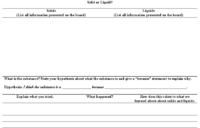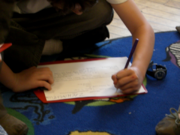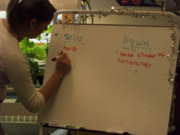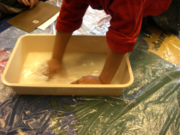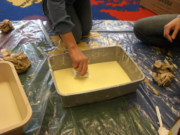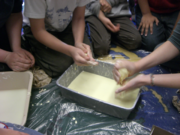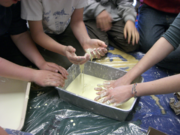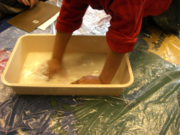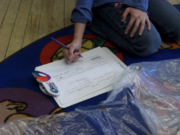Outrageous Ooze
| Instant wiki maker | Making handouts | Editing tips |
Biology In Elementary Schools is a Saint Michael's College student project from a course that ran between 2007 and 2010 and fully described in this book chapter. The student-created resources have been preserved here for posterity. Link under 'toolbox' for printer-friendly versions of the exercises. Click on handouts to print full resolution versions. Please see Wikieducator's disclaimer, our safety statement, and the Creative Commons licensing in English and in legalese.
Student worthiness
This activity is tried and trusted.
Primary biological content area covered
Students will:
- discuss states of matter (solids and liquids)
- use their senses (e.g. sight, sound, smell, touch)
- use scientific observations
- use scientific methodology
<kaltura-widget kalturaid='315478' size='L' align='R'/>
Materials
- 1 cup of cornstarch
- 1/2 cup of water
- Food coloring (optional)
- 1 Large tray or bowl
- Measuring cups
- 1 Paper cup
- 1 Spoon
- 1 Table cloth (plastic)
- 1 Tablespoon
- Worksheets (30-40)
Handouts
Students will be given a handout (Figure 1) on which they will write hypotheses, ideas, and information gathered during our experiment. When the students receive the worksheet, the first step is for them to make a hypothesis in regards to what the outrageous ooze is (solid or liquid). Next the students will write what they did to the ooze (poke it, pull it, pinch it, form it). Then, as a group, compare and contrast the information the students gathered. Allow them to explain what happened during the experiment and how the results of the ooze proves it to be a solid and also a liquid.
Description of activity
Students will be given the opportunity to use mathematics to make their own "outrageous ooze" through measuring cornstarch and water. They will use their senses to hypothesize what element "outrageous ooze" is (solid or liquid). Then, they will use scientific observations and methodology to complete a handout and have a "conclusion discussion" about what the ooze is and how it works.
Lesson plan
Step One-Discussion (5 minutes)
- Give each student a worksheet (Figure 1) and have them fill out the "Solids" and the "Liquids" sections simultaneously during the discussion (as seen in Figure 2). Ask the students how solids and liquids function and react. (e.g. Solids are hard and remain the same shape. Liquids flow and change shape to form what it's put into). Discuss how the molecules are different with each element and allow them to give examples of each type. Write the students' responses on the board so they are able to see the words as they are writing them onto the worksheet (as seen in Figure 3).
Step Two- Make the Outrageous Ooze (10 minutes)
- As a group mix the one cup of cornstarch with the half cup of water to make the Outrageous Ooze. During this activity we assigned jobs to each of the students in regards to scooping cornstarch out of the box and into the one cup, pouring the cornstarch into the bucket, pouring water into the bucket, and mixing the cornstarch with our hands (as seen in Figure 4). We also utilized this time to count how many spoonfuls it took to fill one cup of cornstarch.
Step Three- Make a Hypothesis (2 minutes)
- After the students have seen the Ooze have them wash their hands and go back to their worksheets to create a hypothesis.
- Just in case one student is unsure ask the group what a hypothesis is (an educated guess). Discuss what an educated guess is and in the hypothesis section of the work sheet have the students write if they think the Ooze is a solid, a liquid, or another element and why they believe this.
Step Four- Test your Hypothesis (8 minutes)
- After creating a hypothesis have the students line up and one at a time and have each student take a minute to "play" with the ooze. (Figure 5, Figure 6 and Figure 7) In this time the students should be instructed to "play" with it in a way to distinguish if it is a solid of a liquid.
- After washing their hands again students should fill out the last section of the worksheet where it says "Explain what you tried"- have the students fill in what they did to the Ooze (e.g. poked it, pinched it, slapped it, held it in their hands). When they finish that, have them write what happened as a result of their actions and how it relates to either a solid or a liquid.
Step Five- Activity Wrap Up (5 minutes)
- At the end of the lesson, conclude with a small discussion about what the students thought of this experiment. Explain to the students that Outrageous Ooze is actually a "colloid" and how it's very similar to quicksand. If we interact with the Ooze in a quick manner it is likely to take form similarly to that of a solid. Whereas, if we let it run slowly between our fingers it's more similar to a liquid.
Potential pitfalls
- This activity has the potential of having a high level of fun. It will be easy for students to become excited and hyper. It is important to keep control over the students and to keep them focused on the lesson on at hand.
- It is possible that the ooze will not form to the correct consistency and cause confusion during discussion.
- Ooze/dye could potentially get on children's clothing.
- Students might try to eat the ooze, and it is NOT edible.
Math connections
The students will work with measurements to make the ooze. They will be required to measure a 1/2 cup of water, 1 cup of dry cornstarch, and a few tablespoons of food coloring.
Literature connections
If time permits read a story about outrageous ooze. The book listed below is a suggestion:
Dr. Seuss, 1949, Bartholomew and the Oobleck, Random House, Inc. New York http://en.wikipedia.org/wiki/Bartholomew_and_the_Oobleck Wikipedia: Bartholomew and the Oobleck
Connections to educational standards
Vermont Standards
- 7.14 Students understand forces and motion, the properties and composition of matter, and energy sources and transformations. This is evident when students:
- a. Sort objects and materials according to observations of similarities and differences of properties (e.g., size, weight, color, shape, temperature);
- b.Observe and describe changes of states of matter (e.g., in water)
Next steps
Once you have completed the activity, what other information can be gleaned from the materials and resources at hand? What additional activities could be developed using the equipment and materials you have listed above? What other opportunities to learn can be explored based on student questions and input?
Citations and links
http://www.exploratorium.edu/science_explorer/ooze.html Science Explorer
Reflections
- This lesson was incredible! I had so much fun teaching this with the students and I know for a fact that they had a great time as well!
- It was cool to watch them talk about the different elements and even name elements that we weren't discussing within our lesson (e.g. plasma and gas). They even made up their own type of elements to try and hypothesize what the Ooze was. I can't remember the term they conjured up but it was awesome.
- After doing this experiment the only thing I can say to work on is the cleanliness. I know there's no way to make it a "clean" experiment, but we were absolutely covered in cornstarch. However, it was completely worth it.
I agree that this lesson was awesome! It was great to finally have created an activity that the students were really interested in. Aside from "playing" in the ooze they even seemed excited during the discussion. Their own element they created to describe ooze was "platinum". For the most part the students were extremely well-behaved. They listened well to directions and didn't argue with us when we told them their time was up with the ooze. I think this attests to the idea that when you come up with an intriging lesson students will listen to you. I found myself enjoying the time with the students more than in previous lessons because it was more fun to teach an interesting lesson. When the students were excited it made me excited. I think they were able to learn something knew, specifically the concept of "colloid", but also have fun.
When the mixture didn't turn out exactly right when we made it with one of the groups we worked really well together as a team improvising. One of us took the students attention and discussed differences between solids and liquids while the other two were able to fix the mixture. Though this isn't a typical teacher setting it was the setting we were in and we really worked it well!
I also agree that clean up was a bit of a problem. Perhaps if it had been done at a table it would have helped to keep it cleaner. The plastic sheet was shifted a lot as students rotated around the bucket of ooze.
I thought overall this lesson went very well. I thought we handled everything well for the most part. We had them use the clipboards and paper at first and then after they were done we had them place them behind them so they could work with the ooze. At the end of the lesson and playing with the ooze, we came together and had a group discussion. I think this was a great way to end the lesson, also because we had a group demonstration which is the video clip posted.
I thought it was great to see the students working together to make the ooze. They also came up with the word "platinum" which i thought was awesome, because at third grade i dont think I ever would have come up with that.
I definitely agree with the girls though about the cleanup. It was kind of a challenge, and i feel like if we were in our own classroom things would have been easier. But all went well and hopefully I can do this sometime in my future classroom!
We had to use Outrageous Ooze at the last minute when the plants for our experiment came in frozen. It was a well laid out lesson plan, easy to follow and interpret and the kids loved it!! Overall, Outrageous Ooze is OUTSTANDING! To see the adaptations we made to the the lesson see the "Reflection" section of A Fiery Energy Flow.

